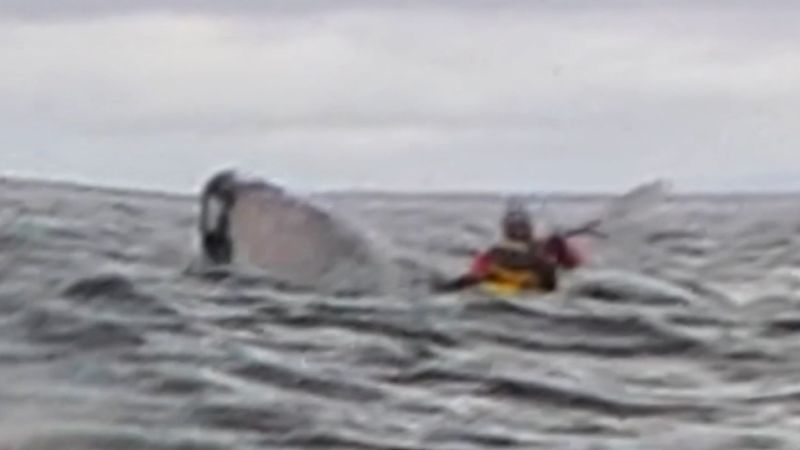
CNN
—
Last Saturday, during a father-son adventure in the chilly waters off Chile’s southern Patagonia region, a young kayaker was temporarily engulfed by a humpback whale. Adrian Simancas, 24, found himself in the unexpected situation while enjoying the stunning surroundings.
The frightening encounter, documented by Adrian’s father, unfolded when the whale surfaced in the Strait of Magellan and briefly took him in before releasing him back into the water.
In the video, authenticated by CNN, sounds of concern can be heard as Adrian’s father, Dell, instructs his son—who had just been ejected from the whale—to “grab the boat” as he swims toward the safety of his father’s pack raft.
“At first, I thought it swallowed me,” Adrian reflected in the video.
Speaking with CNN en Español, Adrian shared his vivid experience of being momentarily consumed by the enormous marine mammal.
“When I turned around, I felt a slippery sensation on my face; colors like deep blue and white swirled around me, and something closed in from behind, plunging me under,” he recounted. “In that instant, I believed I was going to die—I didn’t understand what was happening.”
Yet, despite his confusion, his life jacket buoyed him back to the surface, allowing him to grasp the reality of the situation moments later.
Dell recounted to CNN en Español that he had started recording when he spotted some lively waves that seemed particularly thrilling.
Suddenly, he heard what sounded like a powerful wave crashing nearby, and when he turned to check, neither Adrian nor his raft were visible. Panic set in until he spotted Adrian surfacing with the raft in pursuit.
When asked if they would consider kayaking again, both father and son responded in unison: “Absolutely.”
Marine biologist Vanessa Pirotta explained that at the time of the encounter, the humpback was likely lunge-feeding on krill or fish, and Adrian just happened to be in its path.
“The young man was simply too close to the whale, which was engaged in its normal feeding behavior. He wasn’t actually swallowed,” she clarified.
“These magnificent creatures are not known to target prey the size of humans. Their anatomy, including a narrow esophagus and absence of teeth, prevents them from consuming anything larger than their usual dietary options,” she added.
The Strait of Magellan, renowned for its natural beauty, is a favorite destination for tourists seeking outdoor adventures, including kayaking alongside dolphins and humpback whales, as highlighted on the government’s tourism website.
According to the National Oceanic and Atmospheric Administration (NOAA), humpback whales inhabit all of the world’s primary oceans, making them a common sight for marine enthusiasts.
The NOAA also notes that these whales are a big draw for whale watchers due to their playful surface activities, which often include breaching and slapping the water with their fins or tails.









